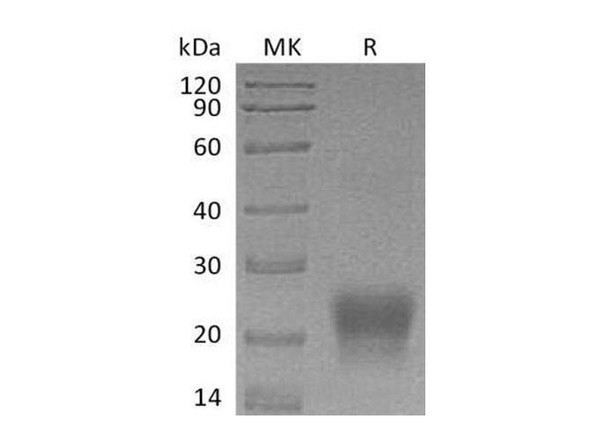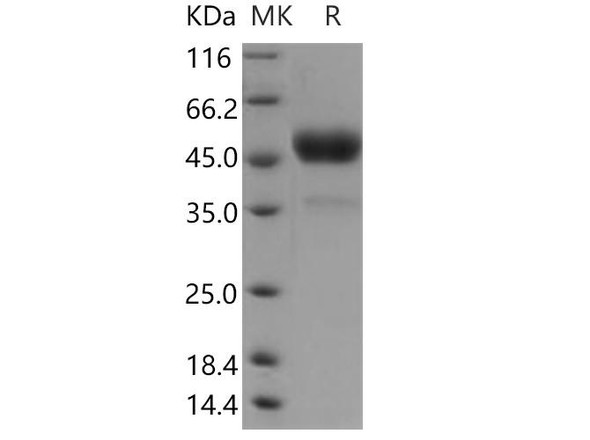Cytokines Recombinant Proteins
Human BST2 Recombinant Protein (RPPB0118)
- SKU:
- RPPB0118
- Product Type:
- Recombinant Protein
- Species:
- Human
- Uniprot:
- Q10589
- Research Area:
- Cytokines
Description
| Product Name: | Human BST2 Recombinant Protein |
| Product Code: | RPPB0118 |
| Size: | 10µg |
| Species: | Human |
| Target: | BST2 |
| Synonyms: | Bone marrow stromal cell antigen 2, CD317 antigen, BST-2, HM1.24 antigen, Tetherin, NPC-A-7. |
| Source: | Escherichia Coli |
| Physical Appearance: | BST2 is supplied as a sterile filtered clear solution. |
| Formulation: | BST2 protein 0.5mg/ml is supplied in 20mM Tris-HCl, pH-8, 0.1M NaCl, 1mM DTT and 20% Glycerol. |
| Stability: | Store at 4°C if entire vial will be used within 2-4 weeks. Store, frozen at -20°C for longer periods of time. For long term storage it is recommended to add a carrier protein (0.1% HSA or BSA).Avoid multiple freeze-thaw cycles. |
| Purity: | Greater than 80.0% as determined by SDS-PAGE. |
| Amino Acid Sequence: | MGSSHHHHHH SSGLVPRGSH MSEACRDGLR AVMECRNVTH LLQQELTEAQ KGFQDVEAQA ATCNHTVMAL MASLDAEKAQ GQKKVEELEG EITTLNHKLQ DASAEVERLR RENQVLSVRI ADKKYYPSSQ DSS |
BST2 takes part in the growth and development of B-cells. The human cellular protein BST2 inhibits retrovirus infection by maintaining the diffusion of virus particles after budding from infected cells. BST2 was originally discovered as an inhibitor to HIV-1 infection in the absence of Vpu, but it is also known to inhibit the release of other viruses such as the Lassa and Marburg virions. In addition, BST2 has a part in B-cell activation in rheumatoid arthritis.
BST2 Human Recombinant produced in E.coli is a single, non-glycosylated polypeptide chain containing 133 amino acids (50-161) and having a molecular mass of 14.8 kDa.The BST2 is fused to a 21 amino acid His-Tag at N-terminus and purified by proprietary chromatographic techniques.
| UniProt Protein Function: | BST2: IFN-induced antiviral host restriction factor which efficiently blocks the release of diverse mammalian enveloped viruses by directly tethering nascent virions to the membranes of infected cells. Acts as a direct physical tether, holding virions to the cell membrane and linking virions to each other. The tethered virions can be internalized by endocytosis and subsequently degraded or they can remain on the cell surface. In either case, their spread as cell-free virions is restricted. Its target viruses belong to diverse families, including retroviridae: human immunodeficiency virus type 1 (HIV-1), human immunodeficiency virus type 2 (HIV-2), simian immunodeficiency viruses (SIVs), equine infectious anemia virus (EIAV), feline immunodeficiency virus (FIV), prototype foamy virus (PFV), Mason- Pfizer monkey virus (MPMV), human T-cell leukemia virus type 1 (HTLV-1), Rous sarcoma virus (RSV) and murine leukemia virus (MLV), flavivirideae: hepatitis C virus (HCV), filoviridae: ebola virus (EBOV) and marburg virus (MARV), arenaviridae: lassa virus (LASV) and machupo virus (MACV), herpesviridae: kaposis sarcoma- associated herpesvirus (KSHV), rhabdoviridae: vesicular stomatitis virus (VSV), orthomyxoviridae: influenza A virus, and paramyxoviridae: nipah virus. Can inhibit cell surface proteolytic activity of MMP14 causing decreased activation of MMP15 which results in inhibition of cell growth and migration. Can stimulate signaling by LILRA4/ILT7 and consequently provide negative feedback to the production of IFN by plasmacytoid dendritic cells in response to viral infection. Plays a role in the organization of the subapical actin cytoskeleton in polarized epithelial cells. Belongs to the tetherin family. |
| UniProt Protein Details: | Protein type:Cell development/differentiation; Membrane protein, GPI anchor; Membrane protein, integral Chromosomal Location of Human Ortholog: 19p13.11 Cellular Component: apical plasma membrane; cell surface; cytoplasm; Golgi apparatus; integral to plasma membrane; membrane; multivesicular body; plasma membrane Molecular Function:metalloendopeptidase inhibitor activity; protein binding; protein homodimerization activity; signal transducer activity Biological Process: cell proliferation; cell-cell signaling; defense response to virus; humoral immune response; innate immune response; multicellular organismal development; negative regulation of cell growth; negative regulation of cell migration; negative regulation of plasmacytoid dendritic cell cytokine production; negative regulation of viral genome replication; positive regulation of I-kappaB kinase/NF-kappaB cascade; regulation of actin cytoskeleton organization and biogenesis; response to virus |
| NCBI Summary: | Bone marrow stromal cells are involved in the growth and development of B-cells. The specific function of the protein encoded by the bone marrow stromal cell antigen 2 is undetermined; however, this protein may play a role in pre-B-cell growth and in rheumatoid arthritis. [provided by RefSeq, Jul 2008] |
| UniProt Code: | Q10589 |
| NCBI GenInfo Identifier: | 1705508 |
| NCBI Gene ID: | 684 |
| NCBI Accession: | Q10589.1 |
| UniProt Secondary Accession: | Q10589,Q53G07, A8K4Y4, |
| UniProt Related Accession: | Q10589 |
| Molecular Weight: | |
| NCBI Full Name: | Bone marrow stromal antigen 2 |
| NCBI Synonym Full Names: | bone marrow stromal cell antigen 2 |
| NCBI Official Symbol: | BST2�� |
| NCBI Official Synonym Symbols: | CD317; TETHERIN�� |
| NCBI Protein Information: | bone marrow stromal antigen 2 |
| UniProt Protein Name: | Bone marrow stromal antigen 2 |
| UniProt Synonym Protein Names: | HM1.24 antigen; Tetherin; CD_antigen: CD317 |
| Protein Family: | Bone marrow stromal antigen |
| UniProt Gene Name: | BST2�� |






